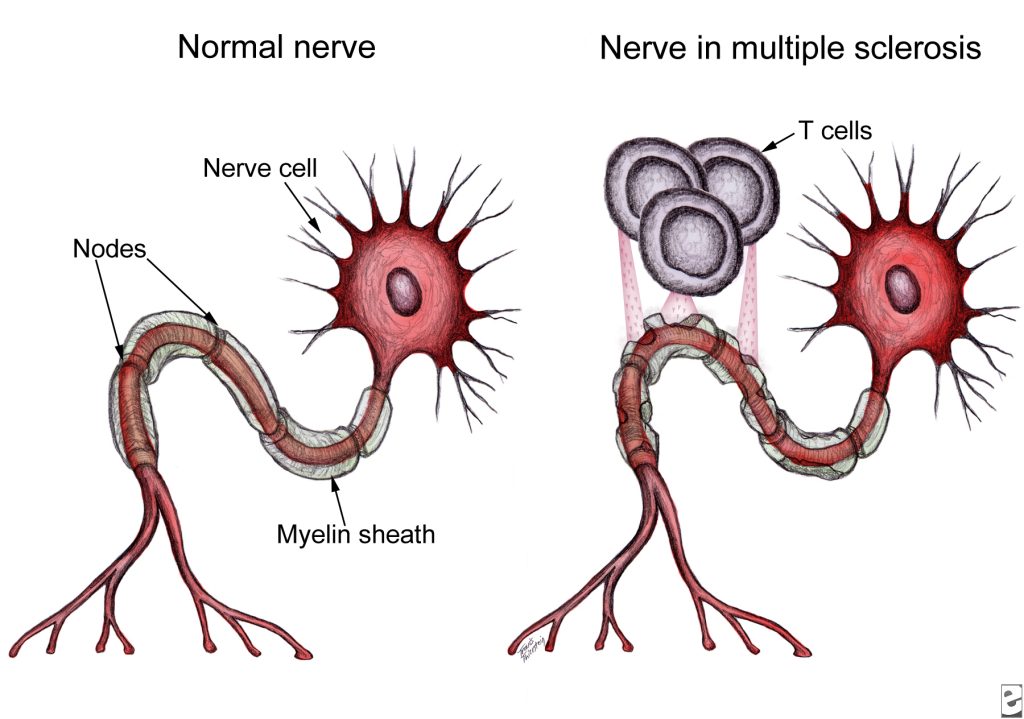Multiple sclerosis is a disease that shares many features with Parkinson’s disease. These diseases are similar as they are chronic, progressive, and their cause is the slow destruction of regions of the nervous system. However, multiple sclerosis or MS has a number of particularities that distinguish it from Parkinson’s disease, which should be mentioned.
First of all, in the disease development, the onset time and the cause of its development are important. Unlike Parkinson’s disease, which develops over the age of 60, multiple sclerosis is a young disease that manifests itself at the age of 20-40, most often in people employed in the intellectual field. The cause of the development of MS, like Parkinson’s disease, has not been completely elucidated, however, it is known that both environmental factors (ecology, infections, geographic features, vitamin D deficiency) and internal factors (hereditary predisposition, inferiority of the immune system, metabolic disorders, etc.). Multiple sclerosis is more common in women than in men.
One of the main theories of the development of multiple sclerosis suggests that immunopathological reactions play a leading role, when the body’s own cells, which are normally responsible for the formation of immunity in response to substances that are foreign to the body (proteins, viruses, bacteria), are activated for some reason against “native” cells of the nervous system and gradually destroy them.
To understand what symptoms arise due to the reactions, and what is the reason for their development, let us dwell on the anatomical features of multiple sclerosis.
Anatomical features of multiple sclerosis and particularities of the disease course
We already know that multiple sclerosis probably develops as a result of the activation of the body’s cells against its own cells in the nervous system. Which cells exactly?
The neurons of the nervous system are connected to each other in long intertwining chains and serve to transmit electrical impulses from one structure to another. So, for example, a pain impulse is transmitted, which is received by the receptors of a finger that has touched a hot object, along a chain of neurons to the brain, where the information is processed, and a new signal is sent back along the “parallel” circuits – to pull the finger back. The speed of transmission of a nerve impulse through neurons is more than 100 m/s. This speed is due to the fact that in order for the electrical impulse not to dissipate and be quickly transmitted, the nerve fibers are covered, like wires, with insulating myelin sheaths. It is against these membranes that immune cells are activated in multiple sclerosis.
Multiple sclerosis; motor neuron; damage of the nerve fiber sheath in multiple sclerosis; damaged myelin sheath; nerve fiber. Above is shown a healthy motor neuron. Below – the damaged myelin sheath of a motor neuron suffering from multiple sclerosis. The damage prevents the transmission of nerve impulses

The disease is called “multiple” sclerosis, because the above changes occur in many foci, both in the central nervous system and in the periphery, which causes a diverse clinical picture of sclerosis.
Symptoms
Damage to the myelin sheaths of nerves leads to a slowdown or cessation of impulse transmission, which causes the following symptoms:

- Leg weakness (often one of the first symptoms of the disease).
- Feeling of numbness in different parts of the body.
- Radicular (nerve roots) pain – acute pain of lumbago type related to any movement of the spine.
- Lermitte’s sign – a sudden short-term pain that occurs when the head is tilted forward and spreads from the top to bottom along the spine, resembling an electric shock.
- Optic neuritis – manifested by “flies” and spots before the eyes, light flashes, a decrease in visual acuity.
- Shaky gait.
- Dizziness.
- Nausea and vomiting.
- Delay or frequent urge to urinate.
Stages of the disease
In the early stages of the disease, symptoms appear gradually, one after another, and not simultaneously, since the myelin fibers of individual nerves are not destroyed by immune cells all at once. Some symptoms, such as optic neuritis, are not permanent and may disappear.
Over time, when the disease progresses, other symptoms appear, due to the damage to the structures at a higher level:
- Paresis is the leading symptom of multiple sclerosis. Paresis is manifested by an increase in muscle tone and involuntary movements in one limb (monoparesis), two limbs (hemiparesis – if an arm and leg are affected, on the one hand, paraparesis – if two arms or two legs are affected), three limbs (triparesis) or four limbs (tetraparesis). For multiple sclerosis, the lower paraparesis is most typical, less often – tetraparesis.
- Ataxia – disorder of coordination of movements. It develops when the cerebellum is affected. Movements of a person with such a typical symptom are awkward, awkward, balance is disturbed in a standing position and when walking.
- Megalography – excessively large handwriting.
- Scanned speech – a slow, fragmentary, syllable-by-syllable pronunciation of words and phrases, is also related to damage to the cerebellar structures.
- Intentional tremor – trembling extending to the limbs, and in severe cases to the head and trunk, which occurs in the final phase of purposeful movements and intensifies as it approaches the target. This symptom is fundamentally different from the resting tremor in Parkinson’s disease, when the tremor, on the contrary, disappears at the beginning of movement and is present at rest.
- Nystagmus – rapid involuntary eye movements.
- Polyneuropathy – occurs in the later stages of the disease and is characterized by systemic damage to the peripheral nerves.
- Neuropsychological disorders – depressive conditions, chronic fatigue, neurosis-like conditions are common.
types of the disease course
Multiple sclerosis develops gradually, the disease symptoms are unstable and change over time. According to the type of the disease course, there are:

- Remitting course – in such a variant, the disease begins with the appearance or sudden increase in pre-existing symptoms, which lasts more than a day, after which remission occurs (disappearance of symptoms).
- Secondary progressive course – such variant develops after remitting and is characterized by periods of exacerbation and stabilization of symptoms, but the disease gradually progresses.
- Primary progressive course – is quite rare, it is characterized by a steady increase in signs of damage to the nervous system without exacerbations and remissions throughout the disease.
Treatment and rehabilitation in multiple sclerosis.
As multiple sclerosis is a chronic disease, treatments are aimed at preventing aggravations and slowing the disease progression. For that, patients should always be monitored by physicians specialized in the disease, strictly comply with the prescribed therapy and combine it with rehabilitation methods on the recommendation of a specialist.
As a drug therapy, patients with multiple sclerosis are prescribed immunomodulatory drugs that slow the disease progression by blocking immune responses. Patients suffering from depressive disorders and chronic fatigue are prescribed antidepressants.
To control the disease progression, an annual MRI and regular necessary tests are extremely important.
Rehabilitation methods
Rehabilitation methods are considered an effective method for the struggle with progression of multiple sclerosis.
Motor rehabilitation
For patients with multiple sclerosis, a rehabilitation physician or physiotherapist should develop a special complex of general strengthening exercises aimed at improving muscle strength in the limbs, relaxing spastic areas, improving balance and coordination, accuracy and speed of movements.
Therapeutic massage
Therapeutic massage is of great importance for the rehabilitation of patients – owing to the regular use of special relaxing techniques, it is possible to achieve a positive clinical effect: relieve muscle spasms, reduce pain syndrome.
Psychological rehabilitation
Helps prevent the development of neurosis-like conditions that often occur with multiple sclerosis.
Physiotherapeutic methods
Physiotherapeutic methods have an anti-inflammatory effect, improve tissue trophism, normalize the body’s immune activity. Such methods as ultraviolet radiation, electrosleep, drug electrophoresis, myostimulation, magnetotherapy, etc. are often used.
Thus, the combination of drug therapy and rehabilitation methods prescribed by a qualified specialist can slow down the progression of multiple sclerosis and increase the period of the disease remission, allowing patients to improve their quality of life.
Video: “Rehabilitation of the patients with Multiple Sclerosis”
For additional information about Rehabilitation of the patients with Multiple Sclerosis you can watch a video demonstrating exercises and rehabilitation recommendations.
Advices from physiotherapists and rehabilitation specialists for patients diagnosed with multiple sclerosis:

Stretching
Stretching is very important, and it is recommended to do it even twice a day for 5-7 minutes. Stretching and increasing flexibility reduces muscle stiffness and tone and helps maintain proper range of motion.
It is necessary to determine the types of occupations and physical activity. Find what you like: Try different types of exercises and see what you like best. Not everything is right for everyone, whether it is walking, cycling, pilates or tai chi, everyone can find something they can do.
aerobic exercise
At the same time, aerobic exercise is very important. They improve the feeling of fatigue reported by many patients, increase overall quality of life, increase heart rate, improve lung endurance, slow down the disease course and may reduce brain damage as because of aerobic exercise, it provides more oxygen to the brain.
If it is difficult to complete one long task or exercise, pause. Effort and respite, again and again. Such training helps maintain normal body temperature.
Sleep and good rest
Sleep and good rest are important for the proper functioning of the body. Those who do not sleep are less focused, and their disease susceptibility increases. Studies show that lack of sleep also affects weight among other aspects, and exercise helps you sleep better.
It is important to observe the principle of gradation and progression: start exercises gradually, check the body’s response to the type of training, make sure that the body responds well, and then move on to the next stage.
Stay optimistic
Stay optimistic: you can live with multiple sclerosis, mental health is closely related to physical health, when you exercise, the feeling of optimism increases, self-confidence returns, and physical condition also improves.
There are hard days. These days, it’s important not to give up. Although rest is very important, there is a wide range from 0 to 100. Even if you do a five-minute workout, it’’s better than nothing. It is enough to walk from the entrance of the house to the end of the street, to get some air, this is important.
In conclusion, try to be as active as possible, even if you don’t exercise by definition. Take the stairs instead of the elevator, park your car farther away and walk, get off the bus one stop early, and do your best to have a healthy and active life style.

Check out the demo version of our sets of exercises for Multiple Sclerosis on YouTube
Our website presents the following sets of exercises for the rehabilitation of the patients with Multiple Sclerosis:
-
MULTIPLE SCLEROSIS. EXERCISES FOR STRETCHING AND IMPROVING BODY FLEXIBILITY AND JOINT MOBILITY, REDUCING TONE
-
MULTIPLE SCLEROSIS. EXERCISES TO STRENGTHEN THE MUSCULOSKELETAL AND MUSCULAR SYSTEM, ENDURANCE
-
MULTIPLE SCLEROSIS. EXERCISES TO IMPROVE COORDINATION, BALANCE AND GAIT
-
MULTIPLE SCLEROSIS. STRETCHING AND WORKING WITH A MASSAGE ROLLER. ADVAN



